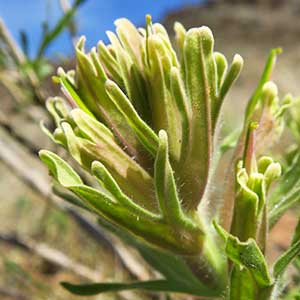Castilleja xanthotricha
Castilleja brevistyla
John Day or yellow-hairy paintbrush, John Day paintbrush, yellow hair paintbrush, yellow-hair Indian paintbrush
short-style owl's-clover, shortstyle Indian paintbrush
few to several, ± decumbent to erect or ascending, unbranched, sometimes with short, leafy axillary shoots, hairs erect to spreading, long, soft, eglandular, mixed with short stipitate-glandular ones.
solitary or few, erect, unbranched, sometimes branched, hairs spreading, short and long, soft and stiff, eglandular.
green, linear, lanceolate to broadly lanceolate, oblong, or cuneate, 0.8–5 cm, not fleshy, margins plane to wavy, involute, 0–5-lobed, apex acute, sometimes rounded;
lobes spreading, linear, arising below mid length, nearly as broad as center lobe, apex acute.
green to purplish, linear to linear-lanceolate, (0.8–)2–6(–8.7) cm, not fleshy, margins plane, flat, 3–5-lobed, apex acuminate;
lobes ascending, linear to narrowly lanceolate, long, apex acuminate to rounded.
3–14 × 1.5–4.5 cm;
bracts proximally greenish, rarely dull reddish purple, distally white to cream, rarely pale yellow or dull, pale pink (sharply differentiated from proximal coloration), lanceolate or oblong to narrowly ovate, (3–)5–7-lobed;
lobes ascending, linear to obovate, ± broadened distally, medium, long, proximal lobes arising below mid length, central lobe apex broadly rounded to truncate, others acute to rounded.
5–25 (longer in fruit) × 1–2 cm;
bracts proximally greenish to dull reddish brown, distally pink, lavender, magenta, purple-red, or white on apices, narrowly lanceolate, (3–)5-lobed;
lobes ascending, linear to narrowly lanceolate with slightly widened apices, medium length to long, arising near or below mid length, apex acute.
curved, 17–23 mm;
tube 15–19 mm;
beak exserted, adaxially green, 5–8(–9) mm, puberulent, stipitate-glandular;
abaxial lip deep purple (color sometimes visible through calyx), green, pinkish, or pale yellow, ± prominent, slightly inflated, usually hidden in calyx, sometimes right at top of calyx, 2 mm, ca. 50% as long as beak;
teeth ascending, whitish, yellowish, pink, or green, 1–1.5 mm.
straight, 15–30 mm;
tube 14–23 mm, not expanded distally, majority of it exserted from calyx;
beak straight, adaxially white or pink (drying purple), 4–6 mm, pubescent;
abaxial lip ± inconspicuous, exserted, pouches 3, 2 mm wide, 1–1.5 mm deep, 3–5 mm, 50–70% as long as beak, white, yellow, or pink with large deep purple, red, or brown spot on each pouch at or extending below middle;
teeth erect, white, yellow, or pink, 1–1.5 mm.
colored as bracts, 15–26 mm;
abaxial and adaxial clefts 3.5–7 mm, 25–50% of calyx length, deeper than laterals, lateral 2–5 mm, 12–25% of calyx length;
lobes linear, oblong, or narrowly triangular, center lobe apex usually rounded, lobes acute to rounded.
colored as bracts, sometimes proximally yellow, 15–20 mm;
abaxial and adaxial clefts 7–9.5 mm, abaxial ca. 33% of calyx length, adaxial ca. 66% of calyx length, deeper than laterals, lateral 3–5.5 mm, 33% of calyx length;
lobes ± linear, slender, all 4 similar, apex acute.
glabrous.
= 48.
= 48.
Castilleja xanthotricha
Castilleja brevistyla
Castilleja xanthotricha is endemic to moderate elevations in the sagebrush hills of the John Day River drainage in north-central Oregon. N. H. Holmgren (1971) hypothesized that this tetraploid species is of allopolyploid hybrid origin between C. glandulifera and C. oresbia.
(Discussion copyrighted by Flora of North America; reprinted with permission.)
Castilleja brevistyla is endemic to the foothills of the southern Sierra Nevada and the southern reaches of the Inner South Coast Ranges, in Kern and adjacent counties. It often grows with other annuals, including C. attenuata, C. densiflora, and C. exserta. The similar C. attenuata has three-lobed bracts and leaves, while C. brevistyla has mostly five-lobed parts, and also differs in corolla structure and spotting. Hybrids between C. brevistyla and C. exserta are known from Kern County.
(Discussion copyrighted by Flora of North America; reprinted with permission.)


